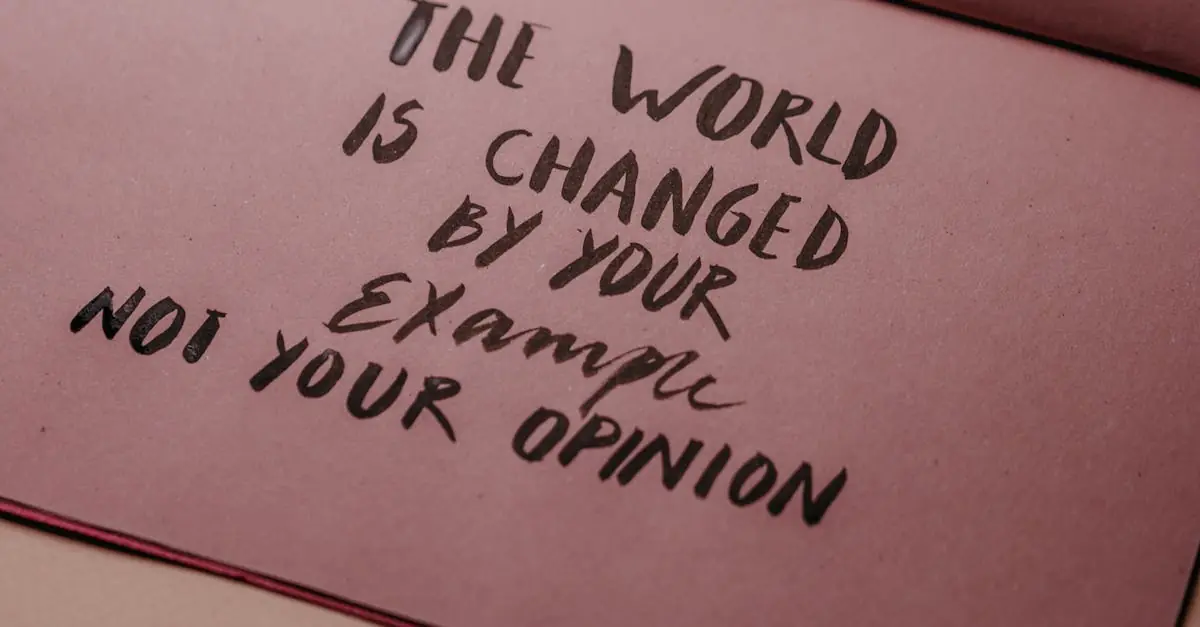Everyone hits a wall sometimes. Whether it’s the dreaded Monday morning or that mid-project slump, finding motivation can feel like searching for a needle in a haystack. But fear not! There’s a treasure trove of motivation examples waiting to spark that inner fire.
Table of Contents
ToggleUnderstanding Motivation
Motivation comprises the internal and external factors that stimulate individuals to act toward their goals. This drive manifests in various forms, helping people overcome obstacles. Intrinsic motivation comes from within, driven by personal satisfaction or desire for self-improvement. Extrinsic motivation involves external rewards, such as praise, recognition, or financial incentives.
Numerous theories explain motivation. Maslow’s Hierarchy of Needs illustrates the progression from basic needs to self-actualization. Achievement motivation emphasizes the pursuit of goals and the satisfaction derived from success. Self-Determination Theory focuses on autonomy, competence, and relatedness as key components that enhance intrinsic motivation.
Practical motivation examples abound across different settings. Athletes often strive for excellence to achieve records or win competitions. Students may seek top grades or mastery of subjects to gain scholarships or job opportunities. In the workplace, employees pursuing promotions may feel motivated by the prospect of increased responsibility and salary.
Visualizing success can boost motivation. Imagining reaching set objectives creates a mental roadmap, making goals more attainable. Setting specific, measurable goals serves to clarify priorities and track progress, fueling motivation sustainably. Celebrating small victories along the way can reinforce positive feelings and maintain momentum.
Identifying barriers to motivation is essential. Environmental factors, such as a noisy workspace, can hinder focus. Emotional challenges, like fear of failure or perfectionism, may impede progress. Addressing these issues allows individuals to cultivate a more conducive atmosphere for motivation to thrive.
Understanding various motivations and recognizing individual preferences can lead to a more effective approach, ensuring consistent drive and enthusiasm toward achieving desired goals.
Types of Motivation
Different types of motivation exist, influencing behavior in various ways. Understanding these can enhance personal drive and goal achievement.
Intrinsic Motivation
Intrinsic motivation comes from within. It involves engaging in activities for personal satisfaction, enjoyment, or a sense of accomplishment. For instance, a student may pursue a subject due to genuine interest, not for grades. This motivation cultivates a deeper connection to tasks, fostering creativity and long-term commitment. Psychological theories highlight that intrinsic motivation leads to higher engagement levels and greater resilience during challenges. Examples include artists creating for the joy of expression or athletes training for personal fulfillment rather than awards. Focusing on intrinsic rewards often sustains motivation over time.
Extrinsic Motivation
Extrinsic motivation relies on external factors. It includes incentives like praise, money, or rewards that encourage action. Many professionals work hard for promotions or bonuses, aligning their efforts with tangible outcomes. This motivation can effectively drive behavior, especially in goal-oriented environments. However, reliance solely on external rewards might diminish intrinsic motivation over time. A common example involves students studying for grades rather than knowledge. Balancing intrinsic and extrinsic motivators can create a more robust motivation framework. Recognizing the importance of both types can lead to improved performance and satisfaction in various settings.
Real-Life Motivation Examples
Motivation varies greatly across different contexts. Numerous examples illustrate how individuals harness motivation to achieve their goals.
Personal Motivation Examples
Setting personal goals can significantly boost motivation. Many people use vision boards, displaying images and quotes that inspire them. Visual reminders create a sense of purpose. Running a marathon offers another example. Training consistently requires dedication and the desire to accomplish a personal best. Celebrating milestones, such as completing a workout or hitting a weight loss target, reinforces motivation further. Connecting with others through fitness groups may also provide the necessary encouragement and support, fostering a sustainable path toward individual aspirations.
Professional Motivation Examples
In professional environments, recognition plays a crucial role in motivating individuals. Many employees perform at their best when rewarded with praise or bonuses for their achievements. Establishing clear objectives aligns team members towards shared goals, enhancing collaboration. Professional development opportunities, such as training or mentorship, inspire employees to enhance their skills and rise in their careers. Companies that foster a positive workplace culture cultivate employee motivation, resulting in higher productivity and job satisfaction. Examples like flexible work schedules emphasize trust and autonomy, further fueling motivation in team settings.
Motivation Techniques
Motivation techniques play a crucial role in enhancing drive and focus. Several strategies exist to help individuals stay committed to their goals.
Setting Goals
Clear goals provide direction and purpose. Individuals achieve greater success when they set specific, measurable targets. Breaking larger ambitions into smaller, achievable steps maintains motivation and boosts confidence. Regularly reviewing these goals acts as a reminder of progress, reinforcing commitment. Incorporating time frames into goals adds urgency, which can further increase motivation levels. Writing down goals enhances accountability and encourages individuals to track achievements. Additionally, sharing goals with trusted friends or family fosters support and encouragement.
Positive Reinforcement
Positive reinforcement encourages desired behaviors through rewards. Recognizing achievements, whether big or small, promotes a sense of accomplishment. Individuals often find motivation increased when they celebrate milestones with treats or personal indulgences. Providing consistent and immediate feedback strengthens this effect, reinforcing the connection between effort and reward. In both personal and professional settings, creating a culture of recognition enhances motivation among peers. Constructive praise, rather than criticism, cultivates a more positive atmosphere, inspiring individuals to push toward future goals. Using positive reinforcement effectively transforms motivation into a sustainable habit.
Motivation is a powerful force that drives individuals toward their goals. By understanding the various types of motivation and applying practical techniques, anyone can enhance their drive and focus. Whether through setting specific goals or celebrating small victories, individuals can create a supportive environment that fosters achievement.
Recognizing and addressing barriers to motivation is crucial for maintaining enthusiasm. By balancing intrinsic and extrinsic motivators, people can sustain their commitment and improve performance across different settings. Ultimately, harnessing motivation effectively leads to personal growth and professional success.



